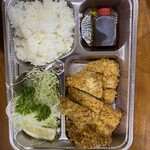
とんかつ かつ味
Tonkatsukatsumi
3.34
Okubo, Shin-Okubo
「Tonkatsu (Pork cutlet)」
1,000-1,999円
--
東京都新宿区大久保2-7-5
Photos
(20)

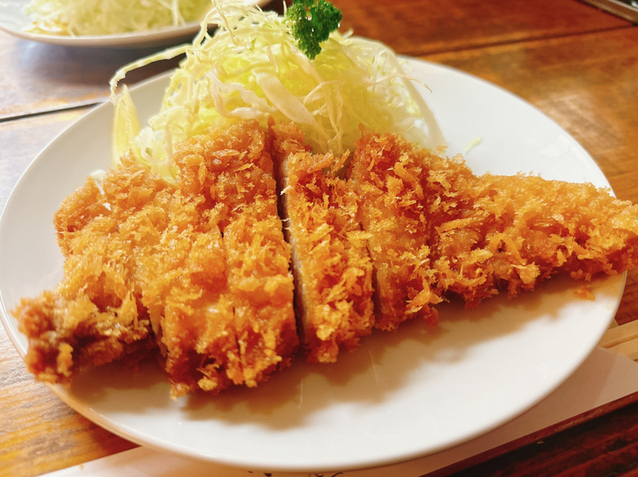
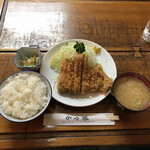

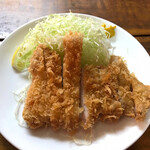
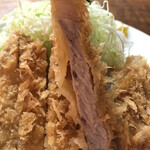
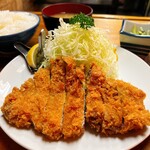
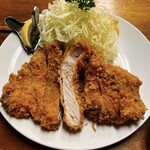
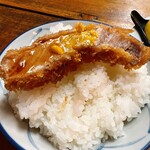

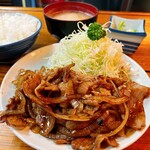
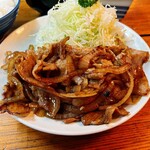
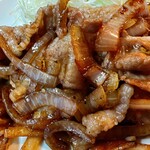
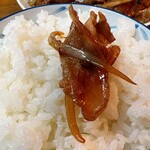
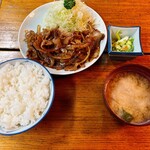
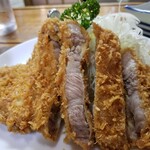
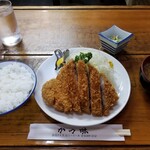
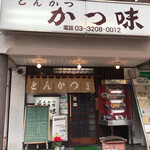

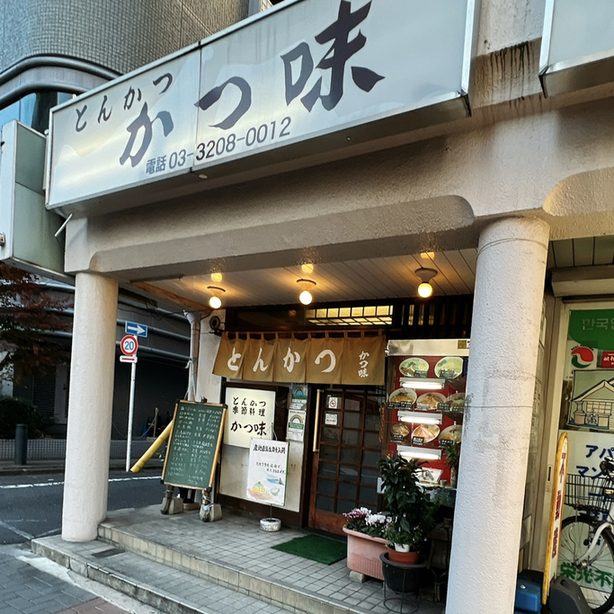
Details
Payment Method
No credit cards
Electronic money is not accepted
Number of Seats
(Table for four seats six)
Private Dining Rooms
None
Smoking and Non-Smoking
No smoking at the table
Parking
None
Facilities
Calm space
Drink
Sake available
Comments
(20)
食い意地ジィジ
3.50
The restaurant had a typical set meal store appearance. Despite the expectations based on this atmosphere and menu prices, the quality of the food was surprisingly high. I went slightly after lunchtime at 2:30 PM. The Special Mix set meal included two pork cutlets and two medium-sized shrimp tempura. With a glass of beer, the total cost was only 2000 yen, which was a great deal. I would like to come back next time for dinner to try the fried horse mackerel with beer.
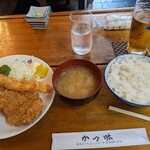
新宿7丁目の紳士
3.50
When it comes to tonkatsu, in the area around Higashi Shinjuku, there used to be Nabentei no Yamakura (closed), Kadoya in Toyama-cho, Yamazaki in Sumiyoshi-cho near Akebonobashi, and Katsu Aji in Okubo Nishicho. Personally, I go to all of them, but the one I feel consistently good about is Katsu Aji. The key to delicious tonkatsu is a crispy coating, tasty sauce, finely shredded cabbage, and tender, juicy meat. Katsu Aji meets all these criteria perfectly. When my stomach is feeling good but I crave tonkatsu, I go for the tenderloin. Today, feeling good, I went for the pork loin katsudon. The miso soup is also delicious, and the pickles are a nice touch. The egg and dashi in the oyakodon are subtly sweet and enticing. The deliciousness that never gets old, even if you eat it every other day. So, for those who live in this area and haven't tried it yet, I highly recommend it.
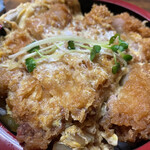
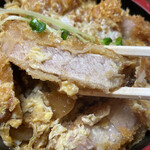

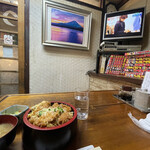
9014Sally
3.60
Today's lunch, I decided to go to Katsuaimi for tonkatsu. When I arrived at the restaurant, I saw they had a limited-time offer for Kaki Fry set meal for 1350 yen, so I decided to order that instead. When I used to eat tonkatsu in Shinjuku, I would often go to Katsuginsan or this place, but unfortunately Katsuginsan has closed down, so now this place is the only option. It was delicious. Thank you for the meal.
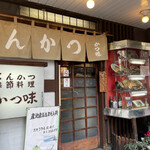
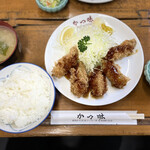

muray805
3.30
Today, I planned to go to that shop in Takadanobaba!! But... the shop I wanted to visit was closed, so disappointing... Hmm, what should I do now? The weather is nice, so I decided to take a walk and explore lunch spots. Oh, I'm getting tired from walking, and my stomach is growling. Ah! I found it!! Alright, let's go in!! I sat at a table at Katsu Aji-san. As usual, I ordered the pork cutlet set for lunch. It's lunchtime, so salarymen are having their meals too. I glanced at the table next to me, and saw someone ordering the katsu-don. The smile on their face when the lid was lifted and the steam rising up, it looked so delicious. I received my pork cutlet set at my table! Alright, let's dig in. I'll start with a piece without any sauce. The crispy and light texture of the meat is easy to eat, and the thickness of the meat is just right. The rice and miso soup are also generous portions, so I feel satisfied. Ahh, that hit the spot. Eating a set meal always leaves me satisfied. I had a good walk, so eating the pork cutlet helped me recover from fatigue. Ahh, it was delicious. Sometimes I think about trying the pork tenderloin cutlet, but in the end, I always go for the pork cutlet! The richness of the pork cutlet is irresistible. Alright, now that I've recharged my energy, I'll take a little more walk before heading back! Thank you for the meal!




officialurara
4.00
The quality at this price of 1150 yen is definitely worth coming back for. The meat is delicious and tender, and the sauce is tasty. It would be even better with some coarse salt. It definitely rivals the taste of famous restaurants. There was no dressing for the cabbage, but you can customize the flavor with sauce, salt, or lemon. The miso soup with tofu was a nice way to warm up.
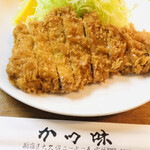
ヤジリン
3.50
Top loin cutlet set meal (served with miso soup and pickles) for 1680 yen. Located near the intersection of Okubo Street and Meiji Street in East Shinjuku. A nice looking tonkatsu restaurant with a welcoming curtain. I decided to splurge on the top loin cutlet this time because the stamina cutlet was delicious last time. The moderately fatty loin was juicy and delicious. One thing that can be said about tonkatsu restaurants in general is that the image of a tonkatsu set meal is crispy tonkatsu on top of fresh shredded cabbage, but the bottom part of the tonkatsu tends to become soggy. It would be nice if there was a way to prevent this. In terms of price, there are tonkatsu restaurants with thicker cuts, but this place has a warm and cozy atmosphere.



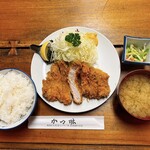
ヤジリン
3.50
Stamina set meal (with miso soup and pickles) for 900 yen. Located near the intersection of Okubo Street and Meiji Street in East Shinjuku. A nice-looking tonkatsu restaurant with a welcoming curtain. As tonkatsu can be expensive for lunch, I opted for the more affordable stamina set. When it arrived, I was surprised by the generous portion. The dish was filled with plenty of meat, stir-fried with onions in a sweet and savory sauce that made the rice go down easily. It was undeniably delicious. I initially thought the restaurant was run by an elderly couple, but it seems the son, who is also quite robust, is the head chef. This kind of restaurant never disappoints. Since there is still limited information about this place, I am eager to explore more.




y31-t775
3.30
About a 10-minute walk east from Shin-Okubo Station, there is a tonkatsu restaurant located near the Okubo 2-chome intersection on Meiji Street. I visited for lunch on a weekday. The interior of the restaurant has a nostalgic atmosphere that seems to be a local staple, with about 7 or 8 tables lined up. Despite the humid weather outside, the air conditioning was moderate, with air circulation provided by a fan. The menu includes the usual tonkatsu options such as fillet and loin. As a unique item, they offer Nagasaki tonkatsu, which is apparently a menchi katsu. I decided to try a combination plate with various types of tonkatsu. The combination plate (fillet, shrimp, kisu fish) set costs 1,020 yen. Although the restaurant wasn't too crowded, there was a considerable wait of about 20 minutes. The combination plate arrived as promised, with a variety of tonkatsu. The shrimp fry had a firm and thick shrimp. The kisu fish fry was a new experience for me, but the crispy batter complemented it well. The fillet tonkatsu was thick and tender, and very delicious. The set also included cabbage, rice, miso soup, and pickles. It was a satisfying meal with a generous portion. Payment is cash only. I look forward to trying the Nagasaki tonkatsu next time.
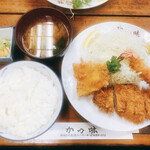

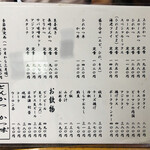

飲んで食ってBMI22
3.10
This is a very Showa-style tonkatsu restaurant located a short walk from Higashi-Shinjuku Station towards Shin-Okubo Station. Inside, there are about 8 tables lined up in a very Showa-style setting, with a family-run atmosphere. The lunchtime is quite popular, with almost all tables full. I ordered the loin cutlet set for 1150 yen. The cutlet is not too big or thick, but has a nice crispy texture and decent flavor. It may be slightly on the expensive side for a non-chain restaurant, but it's worth it for the nostalgic atmosphere and taste.
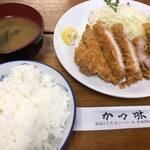

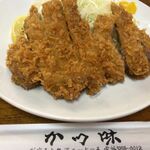
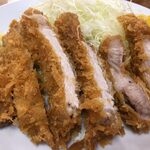
京夏終空
3.70
In the midst of an abundance of weak tonkatsu, I felt the need for a traditional, strong tonkatsu. When discussing tonkatsu, I tend to get passionate. However, upon further consideration, I realize that it may just be a difference in eras. Nowadays, people tend to focus on rare cuts or brand-name pork from certain regions when eating tonkatsu, a concept that was almost non-existent in the Showa era. Back then, people seemed to choose tonkatsu based on factors like the heaviness of the batter, tenderness of the meat, taste of the sauce, portion size, and price. If you were at a tonkatsu restaurant, the conversation might extend to things like the service, atmosphere, or whether they serve alcohol. When I first moved to Ikebukuro 32 years ago, the tonkatsu options were limited. I remember "Tonkatsu Daigaku" being a popular choice. There were also small tonkatsu shops with only a few counter seats in the love hotel district. I recall a flashy chain restaurant called "Tokyo Tonkatsu" opening near the current Karakan location in the north exit, but it disappeared quickly. Now, this restaurant in Okubo, not towards Okubo Station but towards Higashi-Shinjuku Station, brought back memories of "Niimura" and "Katsumi" in the Okubo area. It had been about ten years since my last visit. While I used to consume tonkatsu quite frequently until my 40s, I've cut back in recent years. But every now and then, I crave it. The interior of the restaurant is peculiar, with tables that can be seen as either two-person or four-person seats. It's a bit tricky to decide which way to face when there are only two chairs between tables. When visiting with three people, it's possible that the person sitting next to you could end up facing the opposite direction. I ordered the "Top Loin Tonkatsu Set" (1,680 yen) - as shown in the photo. It's a large, traditional tonkatsu that exudes a certain elegance. I poured the sauce over it and dug in heartily. Yes, this is it. This is what tonkatsu should be like. The lean meat, fat, batter, and sauce all come together harmoniously, making the white rice disappear quickly. There's nothing more to say. As I mentioned before, this is what tonkatsu is all about. I left satisfied. Thank you for the meal. Tonkatsu is best enjoyed with a hearty serving of sauce. Similarly, yakitori should be savored with tare sauce, and sushi with soy sauce. It seems that many people nowadays tend to lean towards salt seasoning for everything, thinking that it allows them to taste the ingredients more clearly. Salt is indeed delicious and necessary for the human body. However, it seems a bit wasteful to overlook the carefully crafted sauces, tares, and soy sauces that chefs and artisans have perfected over the years. While salt may offer a fresh and innovative way of eating, it might also be a form of ancient nostalgia. (By Kyonatsu Shuusora, 2020.9.22)




クレヨンあんちゃん
3.00
Today, I had dinner separately from my wife. On my way home from work, I happened to notice a tonkatsu restaurant called "Katsu Aji" and decided to drop in. My junior colleague, K, also joined me. When it comes to eating tonkatsu, I always go for the premium loin cut. I feel like I can judge a restaurant by their premium loin cut. I ordered the premium loin cut set meal, a pork fillet cutlet, and a bottle of beer. K loves curry, so he ordered the pork cutlet curry. After a while, our tonkatsu arrived. The presentation was good. The pork fillet cutlet was quite large, and the pork cutlet curry had a light-colored roux that reminded me of a nostalgic taste. It had been a while since I had tonkatsu, and my heart was dancing with joy. I poured plenty of sauce and dipped it in mustard. The outside was crispy and quite delicious. However, a couple of pieces were a bit tough and hard to chew, which was a bit disappointing. The pork fillet cutlet was tender and had a good texture, leaving me satisfied. K really enjoyed the pork cutlet curry, saying it was very tasty. I ended up eating too much and left the restaurant with a full stomach. If I pass by again, I would like to stop by for another visit. The toughness of the meat seemed like a coincidence. Thank you for the meal.

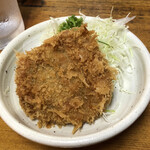

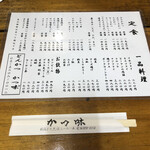
lil-kid
3.30
In this situation, dining out is inevitable, so I narrowed down my options to restaurants within walking distance. This also gave me the opportunity to visit a restaurant in my neighborhood that I had been curious about but hadn't been to before. There was only one other customer when I arrived. I kept my distance, sat down, and ordered the Loin Katsu set meal for ¥1150. The couple running the place seemed to be in their 70s, and the restaurant had a retro Showa-era vibe both inside and out. I could hear the sounds of cooking coming from the kitchen in the back, and after a short wait, my meal arrived. The katsu was lighter in color than I had imagined, with a moderate amount of seasoning and a nice hint of fat. The rice was a bit soft, but still enjoyable. The homemade pickles served generously were a pleasant surprise. The miso soup was also delicious. Overall, the portion size was satisfying. It was a satisfying meal. There was a menu item called "Nagasaki Tonkatsu," and I asked about it, but I'll leave that a mystery for now. I noticed a photo of Yamamoto Linda inside the restaurant, and upon looking around, I confirmed that this place was indeed a Shinano-cho style restaurant.

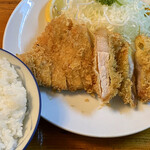


DIZNT
3.50
The bustling Okubo Street in Korea. I tried a traditional tonkatsu restaurant near the intersection of Meiji Street for lunch on a weekday. The interior is quite old-fashioned, but there are quite a few customers and people coming in and out while I was eating. Many seem to be regulars. I ordered the pork cutlet set meal. It was a pretty big cutlet, about the size of a chicken cutlet in a normal restaurant. When I tried it, surprisingly, the meat had a sweet taste and was moderately fatty, quite delicious! The texture was also soft, which explained why there were many regular customers. The cutlet was so big that I almost ran out of rice, but I was satisfied. They also have a variety of side dishes, so it seems like a good place to come for drinks in the evening.

Omochi-chan
2.70
It was delicious! I added a fried horse mackerel as a topping, and the pork cutlet set meal cost 1,640 yen. The rice was slightly soft, and the miso soup and mustard were perfect. It's located near Meiji Street, so there are not many people around, but it has a family-run atmosphere and was bustling.
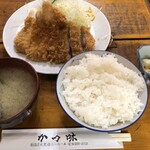
料理おばけ
3.50
I visited a traditional tonkatsu restaurant around 8 pm on a regular day. The place had a small TV and a cozy atmosphere. I ordered the Upper Loin Katsu set meal for 1650 yen, a side of Fried Horse Mackerel for 370 yen, and a bottle of beer for 470 yen. I started with the beer, followed by the Fried Horse Mackerel served first, and then the Upper Loin Katsu. When asked about the rice for the set meal, I decided to have it brought out later. The Upper Loin Katsu had a nostalgic taste and was quite good. The pickles and miso soup that came with the set meal were also delicious. I realized it was a good idea to start with the pickles and slowly enjoy my beer while waiting for the main dish. The Fried Horse Mackerel surprised me with its crispy batter and tender fish. It was tasty even without any sauce. I was impressed by the variety of menu options and will definitely come back. Next time, I might order some appetizers and enjoy a night of drinking. The total cost per person, including the alcohol, was around 500 yen.
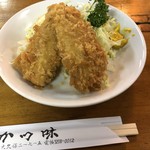
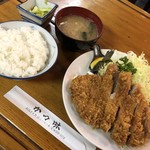
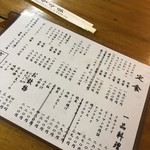
ここもかちん
3.40
Tonkatsu restaurant Yama-kura in Higashi Shinjuku has closed down, and now Katsu Aji on Okubo Street or Katsu Gin in Shinjuku Sanchome has become the closest tonkatsu restaurant to my workplace. Yama-kura closed down when the building it was in was bought by a new business hotel operator, and the successor did not want to continue the business. As for Katsu Aji, it seems to have been operating in this location for quite some time. It is run by a very kind old couple, but it is unclear if they have a successor. I hope they can continue for a long time. On my first visit, I tried the Nagasaki Tonkatsu, which is actually a minced cutlet. It was quite delicious. On my second visit, I ordered the Assorted Set (shrimp, pork fillet, and fish) and enjoyed the variety of flavors. It seems to be a popular choice among the salarymen dining there. I look forward to trying the pork loin set meal that I used to enjoy at Yama-kura on my next visit. It is a very welcoming restaurant.

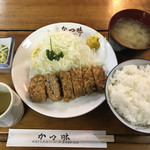
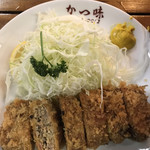
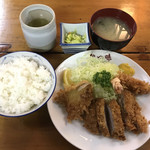
Yuskyy
4.00
A simple tonkatsu that is very satisfying. The atmosphere of the restaurant is unique. I remember it was a very hot day at that time. Eating tonkatsu gave me a boost of energy. It was a lively experience with the tonkatsu DJ playing energetic music.
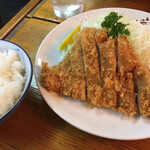
officialurara
3.80
This is a firm and flavorful top loin cutlet priced at 1680 yen. Compared to loin cutlets, it feels like there is a bit more meat. It provides a satisfying tonkatsu experience that fills the heart, making you feel so comfortable that you could almost fall asleep.
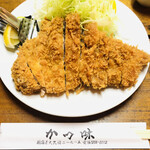
きたろー
4.00
I ordered the seasonal menu Oyster Fry Set for 1300 yen, which is characterized by a light oil and a pale crispy coating. It was fried to a crisp without any greasiness or smell of oil, and it was delicious.
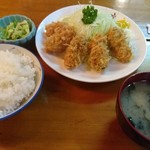
m_naka.
3.50
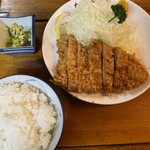
Email Login